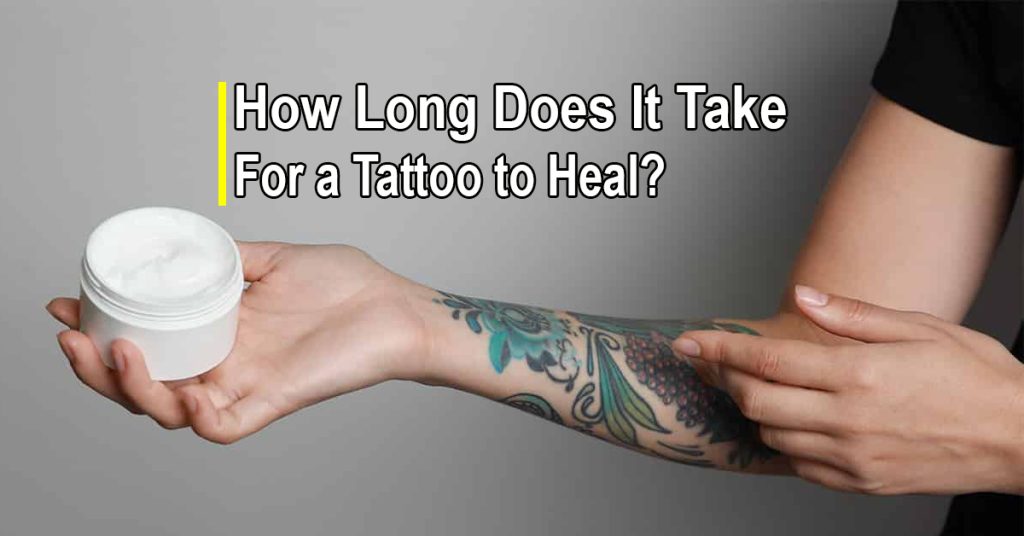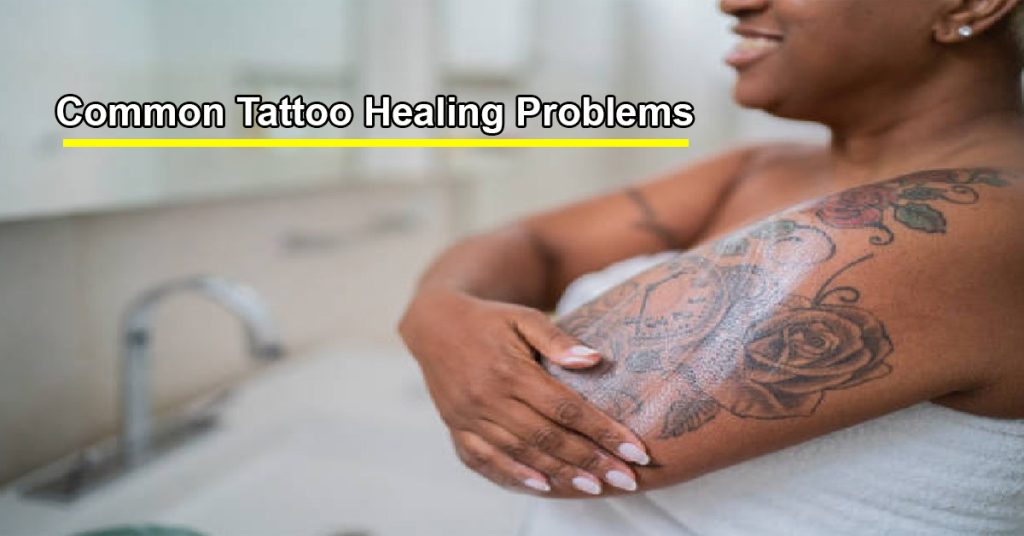How Long Does It Take for a Tattoo to Heal? Complete Timeline and Aftercare Tips
Let’s see How Long Does It Take for a Tattoo to Heal. A tattoo is usually a sign of maturity for many, and a permanent mark that conveys your story or highlights your interests. Once the ink is absorbed on the skin, a crucial issue is: how long will it take the healing process to take place? The process of healing may be as complex than the tattoo itself affected by a variety of factors. including the size, placement and even the individual skin kinds. Understanding the process from the initial ink to the fully healed art is vital not just to maintain an integrity to your brand new tattoo, but also to ensure an optimal level of care.

Introduction to Timeline for a Tattoo to Heal
In this post, we’ll go into the different stages of healing and the things you can expect from each stage. From the beginning days of tingling and peeling to the eventual reveal with vibrant color and a silky surface, knowing what’s ahead will help you understand the transformational experience. You may be contemplating your first tattoo or already tattooed and want additional information about aftercare this guide will give you everything you must know about how long it will take for the tattoo to heal, and the best way to take care of it throughout the process.
How Long Does It Take for a Tattoo to Heal? Overview of the Healing Process
The process of getting a tattoo can be an exciting experience, but healing takes time and perseverance. Let’s look at the general time-frame and the factors that affect it:
General Timeline of Tattoo Healing
- The first couple of moments: your tattoo may appear red and painful. It’s similar to a fancy scratch healing!
- Week 1 A skin may be a little scaly, similar to sunburn. Don’t worry, it’s normal!
- Weeks 2 and 3: The itching begins. It’s an indication that it’s healing However, do not scratch!
- Weeks 3-4 The top layer appears well-healed, however the deeper layers are working.
- A period of 3 months The tattoo should be healing, but the skin isn’t completely healed.
- 4 to 6 months: Completely healed! Your tattoo is now settling into its permanent look.
Factors Affecting Healing Time
Tattoos don’t heal all at the same rate. Here’s how you can help:
- Size of the tattoo: Larger tattoos can require longer time to heal. A larger area means that there is more healing!
- The healing process for some spots is quicker than others: Legs and arms heal in a short time Hands and feet They may take longer because of motion * Joints or ribcage could take longer due to the fact that they move frequently
- The type of skin you have: Every skin is different: The skin that’s oily might heal quicker but requires extra cleansing Dry skin could be more difficult to heal and require more moisturizing. Skin with sensitive conditions may be more susceptible to irritation
- Your overall health: Having a healthy diet as well as staying hydrated and not smoking cigarettes can accelerate healing.
- Follow-up routine aftercare: Following the advice of your doctor is important to speed up healing.
Tattoo Healing Timeline: A Week-by-Week Guide
Let’s take a closer look at what happens during each stage of your tattoo’s healing journey. Remember, everyone heals a bit differently, so don’t worry if you’re slightly ahead or behind this timeline.

Week 1: Initial Healing and Scabbing
The first week is when your body kicks into high gear to start healing:
- Days 1-3: Your tattoo might feel sore and look red and swollen. It’s like your skin is saying, “Whoa, what just happened?”
- Days 4-7: A thin scab starts to form. It’s protecting your tattoo like a little shield.
- You might see some clear fluid oozing – that’s normal! It’s your body’s way of cleaning the area.
Tip: Keep it clean and don’t pick at any scabs!
Week 2: Peeling and Itchiness Stage
This week, things might get a little flaky:
- Your tattoo will start to peel, kind of like a sunburn. Don’t freak out – it’s totally normal!
- You might feel super itchy. It means it’s healing, but resist the urge to scratch!
How to handle the itch:
- Gently pat the area instead of scratching.
- Apply a thin layer of unscented lotion.
- Try a cool compress if it’s driving you crazy.
Week 3-4: Slowing Down the Healing Process
The healing process starts to chill out a bit:
- Your tattoo might look a bit dull or cloudy. Don’t panic! It’s just your skin doing its thing.
- The itchiness should start to fade.
- Any remaining scabs should fall off on their own.
Signs of good healing:
- Less redness and swelling
- No more oozing
- The skin feels less sensitive
Week 5 and Beyond: When Is a Tattoo Fully Healed?
You’re in the home stretch now!
- Most tattoos are considered “healed” after about 4-6 weeks.
- But remember, deeper layers of skin are still settling for several months.
- Your tattoo might look a bit shiny or waxy – that’s new skin forming.
Long-term care tips:
- Keep moisturizing daily.
- Protect your tattoo from the sun with clothing or sunscreen.
- Touch-ups might be needed after a few years to keep it looking fresh.
Remember, a fully healed tattoo is like a work of art that’s finally dry – it needs care to stay vibrant! If you ever have concerns during the healing process, don’t hesitate to reach out to your tattoo artist. They’ve seen it all and can give you personalized advice.
Tattoo Aftercare Tips: How to Take Care of Your New Ink
Care for your new tattoo is crucial to ensure that it heals properly and look stunning. Let’s look at some important tips and techniques!
Essential Tattoo Aftercare Products You Should Use
Here’s your shopping checklist:
- Gentle soap with no fragrance: to keep your tattoo clear and free of irritation.
- Healing ointment: similar to Aquaphor or A&D for the first few days.
- Unscented moisturizer: to keep your skin hydrated while it heals.
- Soft clean towels are ideal for lightly rubbing your tattoo to dry.
Be aware that less is typically more. It’s not necessary to pile on a ton of products!
What to Avoid During the Healing Process?
Certain things can affect the healing process of your tattoo. Here’s the things to stay away from:
• Swimming There are no pools, hot tubs or beach trips for at least 2 weeks.
• Sun exposure Avoid getting your tattoo in the sun. from direct light.
• Close fitting clothes Don’t be afraid to let your tattoo breathe!
• Scratching or picking: Hands off regardless of how tempting!
• Workouts that are intense are not recommended for a few days in order to keep from sweating too much.
Proper Moisturizing Techniques for a Healing Tattoo
Moisturizing is essential However, there’s a proper method to apply it:
- When should you start? Usually within the first 3 to 5 days, after the scabs have fallen off.
- What frequency: 3 to 4 times per day, or when the tattoo is dry.
- How much: It’s one thin layer. Your tattoo shouldn’t appear like it’s gotten greasy.
- Technique Method: Gently rub the moisturizer onto your skin, but Don’t rub!
Common Tattoo Healing Problems and How to Solve Them
Even with the best of care there are bound to be bumps on the road. Here’s what you should be looking out for:

Signs of Infection: When to See a Doctor
If you are experiencing these symptoms then it’s time to contact your doctor:
• Chest or fever
• A redness or swelling that is getting worse and not getting better.
• The smelly discharge or pus
• Hot-to-the-touch or extreme pain around the tattoo
Do not wait until you’re anxious infections can be serious business!
Dealing With Peeling or excessive Scabbing
A little scabbing is common However, if it’s very thick or overly thick:
• Don’t peel or pick! Let it slide off easily.
• Make sure the area is well-groomed and clean.
• If the scabs appear to be very dense, talk to your artist. You may have to alter your regimen.
For dry, peeling skin:
• Apply a little more moisturizer.
• Apply cool compresses to the area if scratchy.
• Drink plenty of water!
Tattoo Fading During Healing: What’s Normal?
Don’t worry when your tattoo appears slightly faded as it heals
• The tattoos are likely appear less vivid after healing.
• Colors usually “pop” again once fully healed.
• If the color is still faded after 4-6 weeks, speak with your artist about the possibility of touch-ups.
Remember that each tattoo heals in a different way. If you’re not sure you’re not sure, talk to your artist, or medical professional. They’re experts and will want your tattoo to look the best it can, just as you!
How Long Does It Take for a Tattoo to Heal? FAQs
Got questions about tattoo healing? Don’t worry! Let’s take a look at a few of the most frequently asked questions that people ask:
Does the time for healing differ based on the style of tattoo?
Sure, it could! The following are some ways that different styles can impact healing:
Simple line work is often faster to heal generally within a couple of weeks.
- Tattoos with colors: Could take a little longer about 3-4 weeks.
- Shading and specific work: May take between 4-6 weeks to completely heal.
The style of watercolor: Identical to tattoos with colored ink, approximately 3-4 weeks.
Keep in mind that these are only estimations. The healing time for your tattoo could be quicker or take longer.
Is that normal for a tattoo to be painful after a couple of weeks?
It’s not uncommon However, here’s what you need to know:
- Week 1: Some soreness is completely normal.
- Weeks 3-4 The majority discomfort should have gone.
- After 4 weeks, if you’re still experiencing pain consult your doctor or artist.
The tenderness may last for an extended period, especially with more intricate or larger tattoos. However, sharp pain or growing soreness isn’t typical and should be ruled out.
How can the body part influence how healing happens?
Location, location, location! The location of your tattoo can have a significant impact:
- Legs and arms usually heal quicker because there’s a good flow of blood.
- Feet and hands can take longer to heal as we are constantly using them.
- Joints and ribcage It could be slow because the skin is stretched and moved quite a bit.
- Back: Usually heals quickly, but it is difficult to take care of because it’s difficult to reach.
- The wrists and ankles It is possible to delay treatment because of constant movement.
Tips Note: In the event that your tattoo falls situated in an area that moves frequently, you may require extra care while the healing process.
Bonus FAQ: Can I accelerate the healing process?
If you don’t want to rush yourself, your body can assist it move along:
- Be sure to follow the aftercare directions attentively.
- Keep hydrated and eat health food.
- Make sure you get enough rest Your body will heal while you sleep!
- Avoid smoking – it could hinder the healing process.
- Keep your tattoo away from the sunlight.
It’s important to remember that healing isn’t a race. It’s better to take your time and carefully than to speed up and end up harming your new ink!
Got more questions? Do not be shy to ask the tattooist. They’ve seen everything and will give you individualized guidance based on your particular tattoo and your skin type. Enjoy healing!
Conclusion: Patience and Care – The Keys to a Beautiful Tattoo
Let’s wrap this with a freshly tattooed tattoo! We’ve covered a lot details about the time it takes for tattoos to heal, and how to take care of it. Let’s go over the key aspects:

- Healing Timeline:
- Week 1 The first healing phase and scabbing
- Week: Itching and peeling
- Weeks 1-3: Slowed down and getting settled
- 4 to 6 weeks: Generally regarded as “healed”
- 2- 6 Months: Completely settled
2. Aftercare Essentials:
- Make sure to keep it clean using gentle soap
- Moisturize properly
- Stay clear of sunlight exposure, and picking at the scabs
3. Every Tattoo is Unique:
- Healing times may vary according to the type, size and place of residence
- Your body, as well as your skin type can play an important role too.
Keep in mind that patience is your greatest friend when you’re dealing with healing your tattoos. It’s tempting to hurry the process along or fret about every tiny alteration, but believe me that your body knows exactly what’s going on. Follow your routine for aftercare and in no time you’ll have your tattoo appearing its best.
If you’re ever in doubt or questions about your healing, do not hesitate contact an artist who tattoos you or medical professional. They’ll help you ensure that your ink looks beautiful over the long term.
So, wear that healing tattoo with pride, remember the tips for aftercare, and then display your newly healed masterpiece in just a few weeks. Enjoy your healing and your amazing new tattoo!


